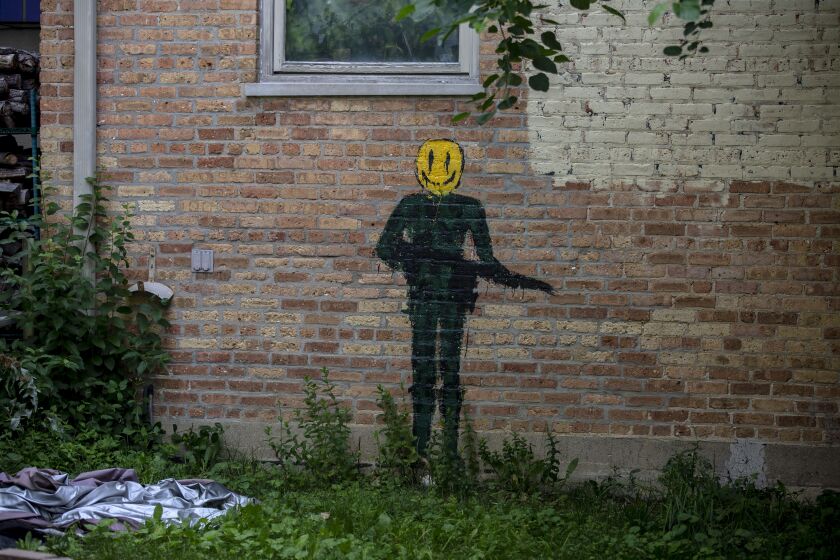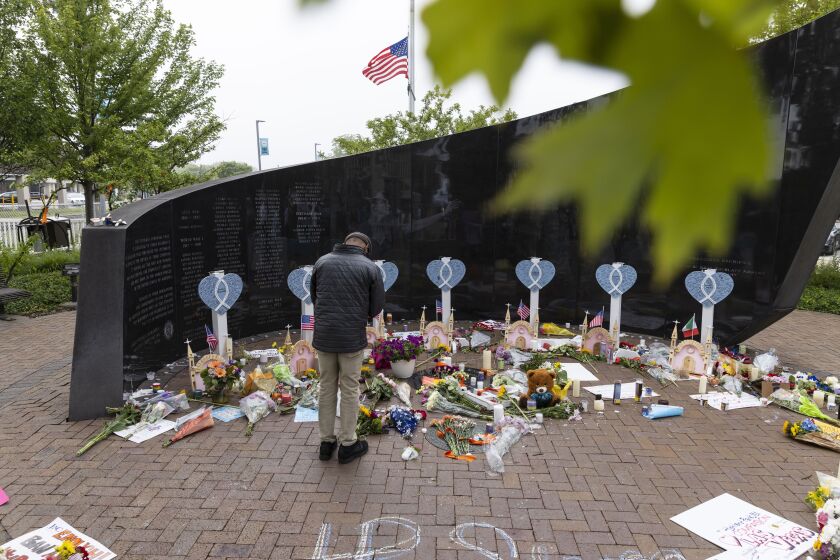Highland Park parade mass murder suspect Robert E. Crimo III through people who knew him, police reports
Father Bob #FatherBob

Growing up in Highland Park, where kids typically are expected to go to college and often beyond, Robert E. Crimo III stood out, according to people who knew him.
Crimo, 21, who’s charged with killing seven people and wounding dozens of others in a mass shooting at the suburb’s Fourth of July parade, dropped out of Highland Park High School before his junior year.
Then, he vanished from the lives of the kids he’d passed in the hallways of the 2,000-student school.
“Seeing him in the halls, I thought he was kind of creepy,” says Ethan Absler, 22, who was a grade ahead of Crimo and recently graduated from the University of Missouri and works for USA Network.
“When he left Highland Park High School, he left people’s radar,” Absler says. “The red flags he was posting on social media went unnoticed because he wasn’t connected to many of the people at the school.”
Looking back, it’s easy to spot warning signs he was troubled.
He bought military-style rifles at a young age and posted videos online of bloody, animated shootings.
Performing as Awake the Rapper, he posted music videos with violent, bloody images and one that shows him with a newspaper with a story about President John F. Kennedy’s assassin Lee Harvey Oswald being killed.
His appearance also made him stand out. The police said he’s 5-11 and 120 pounds. His videos and photos, including the police mug shot taken after his arrest, show tattoos on his face and neck.
Police records and interviews with people who knew Crimo paint a portrait of a troubled young man who grew up in a troubled home.
Called on a regular basis to the family’s home regarding trouble between his parents, who called the police on one another, officers took note of Crimo, describing him in their reports as having suicidal thoughts, threatening to kill his family, to “kill everybody,” smoking marijuana.
He has a brother and sister. His page on the IMDb website for performers says he’s the second of three children. They aren’t mentioned in the police reports of their visits to the home.
In 2002, when Crimo wasn’t yet 2 years old, his mother Denise Pesina left him unattended in a car with the windows rolled up on a hot August day for almost half an hour in a parking lot in Highland Park, court records show. She pleaded guilty to a charge of child endangerment and was ordered to undergo an evaluation at a child advocacy center, the records show.
Pesina couldn’t be reached. Nor could Crimo’s father Robert Crimo Jr., who owned the now-closed Bob’s Pantry & Deli in Highland Park and once ran for mayor of the suburb.
Police officers visited the Crimos’ Highland Park home nearly 20 times between 2009 and 2014, records show. Nine calls involved reports of domestic violence, though no arrests were made.
One time, in 2010, Crimo’s father told the police his wife struck him in an arm with a screwdriver. He later retracted the accusation. No charges were filed.
Often, the police reports show, alcohol appeared to be involved in the couple’s difficulties. In their reports, officers said they recommended they go through marital counseling or separate. They no longer live together.
Jeremy Cahnmann ran an after-school sports program at Lincoln Elementary School in Highland Park and remembers the Crimo family.
“Bobby was in my Nerf football program and maybe some other ones,” Cahnmann says. “He and his brother were average athletes and didn’t cause a lot of trouble.
“What stood out is that almost every day after the program ended, those kids were the last ones waiting for their parents to pick them up,” he says. “It was a problem because a school faculty adviser couldn’t go home until all the kids were picked up.
“Look, I come from a messed-up family,” Cahnmann says. “We all have our skeletons in the closet. But the amount of red flags in this case were right there for the parents to see, and they ignored them and ignored them.”

A mural on the back of the house where Robert E. Crimo III’s mother lives in Highland Park.
Jim Vondruska / Getty Images
Michele Rebollar says her sons were friends with Crimo for a time in their teens. She remembers him sitting on a couch at their home and not talking to anyone.
One of her sons became friends with him in eighth or ninth grade, she says, but got to be friends with others and fell away from Crimo.
Later, Crimo became friends with her late son Anthony LaPorte, who was five years older. Rebollar says she didn’t learn about the friendship until her son’s funeral in 2017 following a drug overdose.
“They were together at night just walking and talking and hanging out in Anthony’s room,” she says.
She says she learned that her son had become a sounding board for Crimo during late-night talks.
But Rebollar and her other sons didn’t keep in touch with Crimo after the funeral.
In April 2019, when Crimo was 18, Highland Park police officers were called to the family’s home after a call that he’d “attempted to commit suicide with a machete.” The incident was “handled last week by mental health professionals,” according to a police report that also said, “Bobby is known to use marijuana” and “has a history of attempts.”
In September 2019, the police said they were called back to the home after Crimo threatened to “kill everyone.” The police confiscated a 12-inch dagger, a “24-inch samurai-type blade” and a box of 16 hand knives. But they returned them to Crimo’s father, who said he told them they were his. Crimo and his mother denied he had threatened anyone, and no arrests were made.
But the officers filed a “clear and present danger” report with the Illinois State Police, which police and teachers are required to do when they think someone poses a threat to the public and shouldn’t be allowed to have a gun.
Months later, Crimo’s father signed a consent form in 2019 that his underage son needed to get a state firearm owner’s identification card that would allow him to lawfully buy guns.
In January 2020, the state police approved allowing Crimo III getting the FOID card.
The director of the state police says there was no basis, under the law, to deny him the card and no evidence Crimo posed a threat to the public.
The following month, February 2020, using the Highwood address of the home where he was then living, Crimo went to a Chicago-area gun store and bought the Smith & Wesson M&P15 semi-automatic rifle that the police say was used in the Fourth of July massacre.

An M&P15 rifle on display at a Las Vegas gun expo.
Authorities say he also bought four other weapons: a Remington 700 bolt-action rifle, a foldable Kel-Tec Sub 2000 rifle, a shotgun and a Glock handgun.
The M&P15 — the initials stand for military and police, according to the manufacturer — was fired more than 80 times at parade-goers as floats and bands passed through the streets of downtown Highland Park on Monday, authorities say.
Though Crimo’s father provided the parental signature his son needed to buy the military-style rifle, he was quoted in an interview with the New York Post as saying he bears “zero” responsibility for the Highland Park Fourth of July shootings, which prosecutors have said his son has confessed to.
The story also quotes the father as saying he spoke with his son on July 3 about a mass shooting that day in Denmark in which a 22-year-old man has been charged with shooting and killing three people at that country’s largest shopping mall.
“He goes, ‘Yeah, that guy is an idiot.’ That’s what he said!” the newspaper quoted Crimo’s father recalling his son saying of the Denmark shooter.
It also reported the father said his son told him that “people like that” commit mass shootings “to amp up the people that want to ban all guns.”
Absler remembers having first-period P.E. with Crimo at Highland Park High School.

Ethan Absler, who also went to Highland Park High School, on Robert E. Crimo III in high school: “He was in his own world.”
“He was reserved, mysterious,” he says. “My friends said he was constantly promoting his rap music career. He was putting stickers promoting his music all over. It was an animated picture of himself. He wasn’t doing his assignments, not listening to teachers. When a teacher would talk to him, he would pretend not to hear it. He was in his own world.”
Absler says he knew two of the people killed in the July 4 massacre: Jacki Sundheim, who was his preschool teacher at the former Gates of Learning in Highland Park, and Katherine Goldstein, the mother of one of his high school classmates.
“It’s such a tight-knit community,” he says. “Everybody knows somebody who was shot.
“Nothing to me indicated he was angry or violent or capable of that,” he says.

Robert E. Crimo III in a Highland Park High School yearbook.
Even with Crimo’s history, it’s not as if Absler or anyone else could have predicted that one day he’d be accused of mass murder, experts say.
“We don’t really know much about how to predict mass shootings, and we don’t really have a profile of a shooter, what the characteristics are. They are shared by millions of people,” says Laura Wilson, an associate professor of psychology at the University of Mary Washington in Virginia. “There aren’t any clear-cut characteristics that we can definitively say, this is the mold.”
A recent study by the Secret Service found that rampage shooters often tell family or friends of their plans.
“The main thing that we’re looking for and listening for would be people sharing that they’re going to do something like this in the future,” Wilson says. “Clinical psychologists talk about it in the terms of ‘leakage,’ where people start to post things on social media, mention things in passing. They might be vague things.
“But you can listen and identify patterns, connect the dots that they’re dropping hints that they’re going to do something.”
Absler says that, after Crimo dropped out of high school, he never thought about him again — until he saw his photo in news coverage of the killings.
“I always felt passionate about gun safety,” he says. “But it took this literally coming to my hometown and shooting my friends for me to realize that it’s not just a news headline, and people’s lives are changed forever.”
Elvia Malagón’s reporting on social justice and income inequality is made possible by a grant from The Chicago Community Trust.

A mourner bows his head Wednesday at a memorial at Central Avenue and St. Johns Avenue for the seven people killed by shots from a rooftop with a semi-automatic rifle down on the crowd gathered Monday for Highland Park’s Fourth of July parade.
Anthony Vazquez / Sun-Times